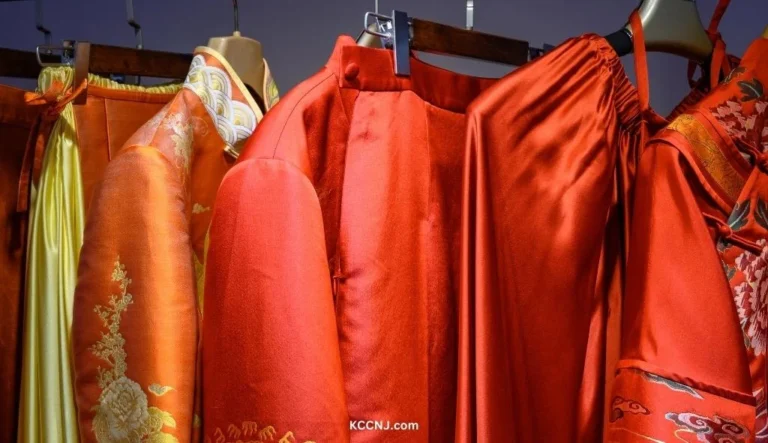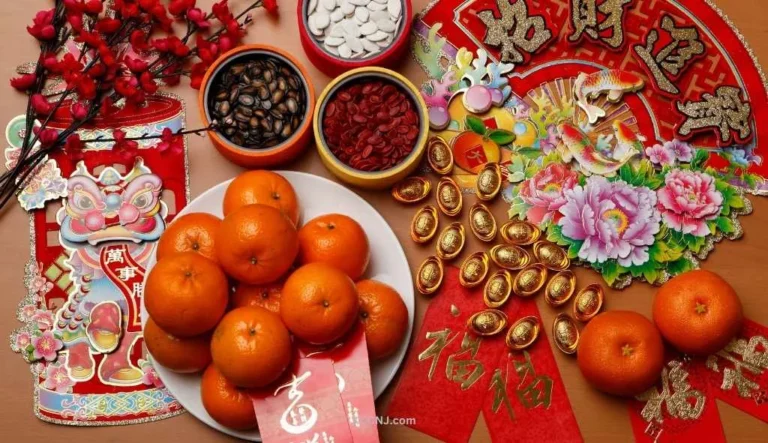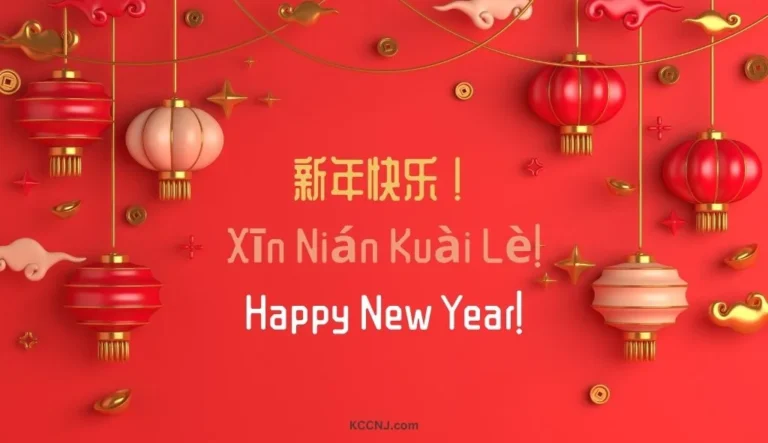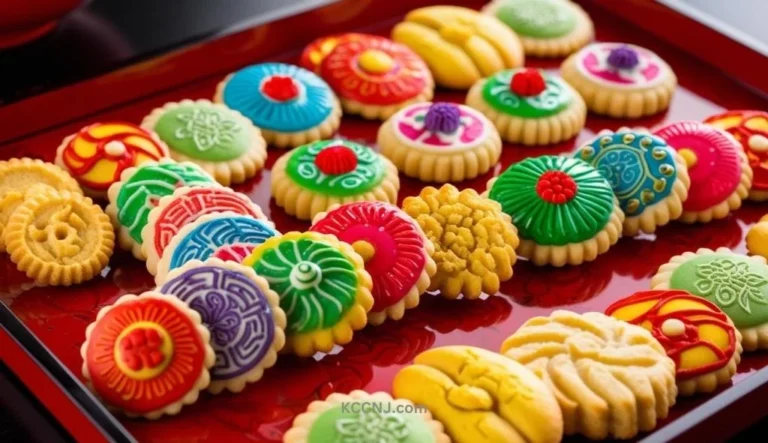10 Inspiring Chinese New Year Poems: 2025 Snake Year
Chinese New Year 2025 celebrates the Year of the Snake with traditional poems that capture the spirit of renewal and prosperity. Here are the top 10 Chinese New Year poems for 2025, blending ancient wisdom with modern celebrations.
Understanding Chinese New Year Poetry
Chinese New Year poetry has a rich history dating back centuries. These poems, known as “chunlian” or Spring Festival couplets, are an essential part of the holiday celebrations. They typically express wishes for good fortune, prosperity, and happiness in the coming year.
The Significance of Poetry in Chinese New Year Celebrations
Poetry plays a central role in Chinese New Year festivities. Families often hang couplets on their doorways or write them on red paper to decorate their homes. These poems serve as both decoration and a way to invoke blessings for the new year.
Characteristics of Chinese New Year Poems
Chinese New Year poems usually have these features:
- Written in couplets (two lines that rhyme or have parallel structure)
- Often contain references to nature, especially spring
- Use auspicious words and phrases
- May include wordplay or puns
- Typically have a positive, uplifting message
Chinese New Year Poems for 2025
Here are ten poems selected for the 2025 Chinese New Year celebration, which marks the Year of the Snake in the Chinese zodiac.
1. “Spring Dawn” by Meng Haoran
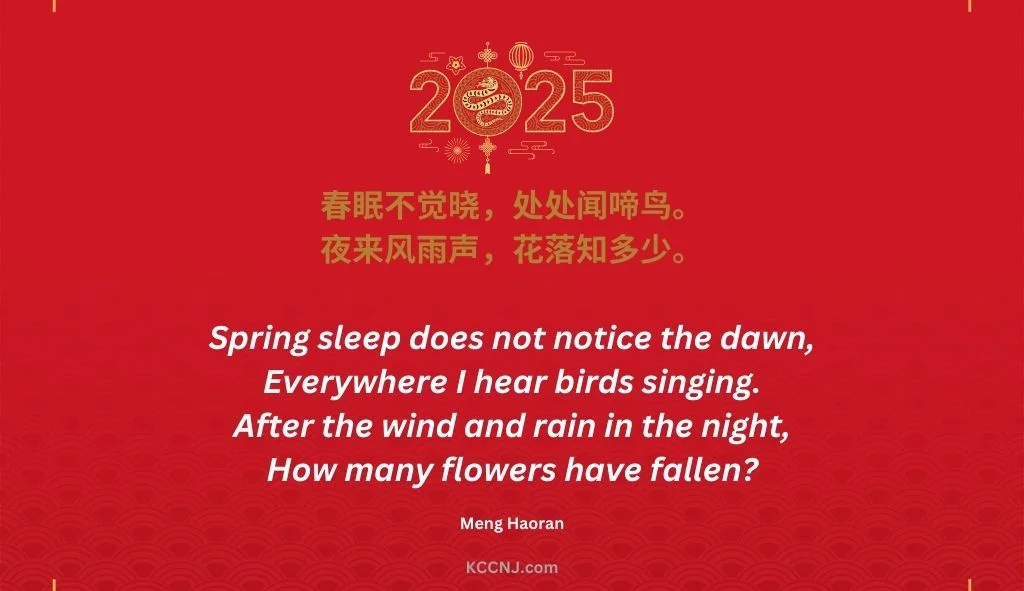
A poem that welcomes the new year with the beauty of nature:
春眠不觉晓,处处闻啼鸟。
夜来风雨声,花落知多少。
Chūn mián bù jué xiǎo, chù chù wén tí niǎo.
Yè lái fēng yǔ shēng, huā luò zhī duō shǎo.
In English:
Spring sleep does not notice the dawn,
Everywhere I hear birds singing.
After the wind and rain in the night,
How many flowers have fallen?
This poem reflects on the changing seasons and the renewal that comes with spring, which aligns with the spirit of Chinese New Year.
2. “Welcoming the Snake Year”
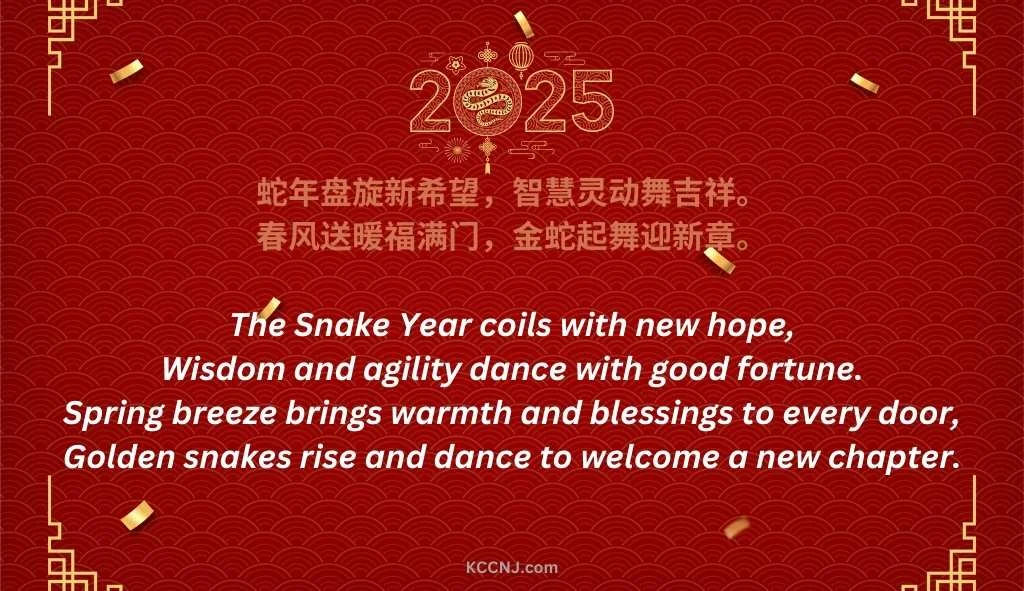
A modern poem created for the Year of the Snake in 2025:
蛇年盘旋新希望,智慧灵动舞吉祥。
春风送暖福满门,金蛇起舞迎新章。
Shé nián pán xuán xīn xī wàng, zhì huì líng dòng wǔ jí xiáng.
Chūn fēng sòng nuǎn fú mǎn mén, jīn shé qǐ wǔ yíng xīn zhāng.
In English:
The Snake Year coils with new hope,
Wisdom and agility dance with good fortune.
Spring breeze brings warmth and blessings to every door,
Golden snakes rise and dance to welcome a new chapter.
This poem incorporates the snake zodiac sign, emphasizing its positive attributes and the hope for a prosperous new year.
3. “Prosperity and Peace”
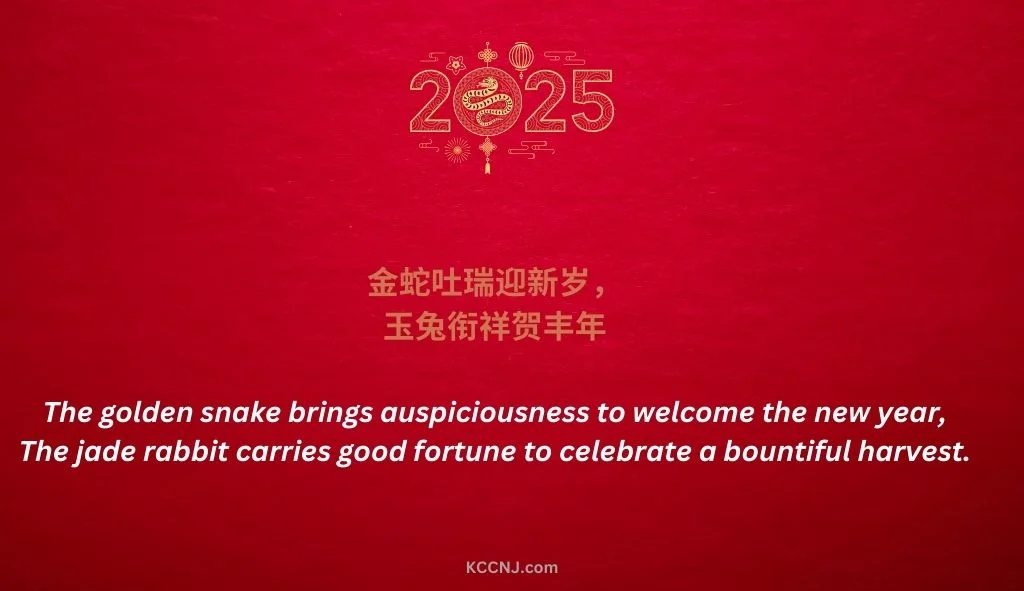
A traditional-style couplet for the New Year:
金蛇吐瑞迎新岁,玉兔衔祥贺丰年。
Jīn shé tǔ ruì yíng xīn suì, yù tù xián xiáng hè fēng nián.
In English:
The golden snake brings auspiciousness to welcome the new year,
The jade rabbit carries good fortune to celebrate a bountiful harvest.
This couplet combines elements from different zodiac signs to create a harmonious and prosperous image for the new year.
4. “Renewal and Growth”
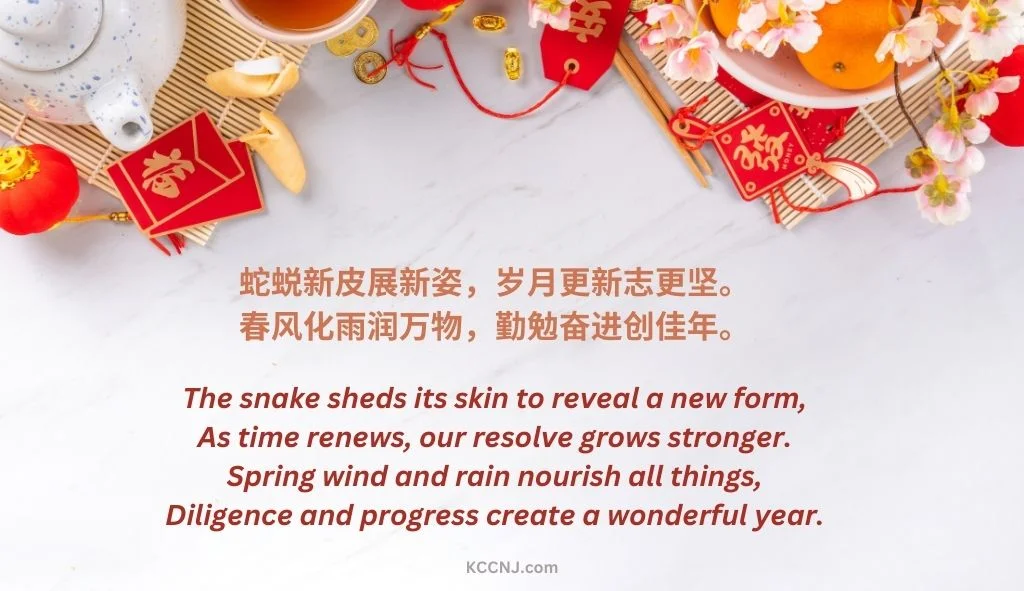
A poem focusing on personal growth in the new year:
蛇蜕新皮展新姿,岁月更新志更坚。
春风化雨润万物,勤勉奋进创佳年。
Shé tuì xīn pí zhǎn xīn zī, suì yuè gēng xīn zhì gèng jiān.
Chūn fēng huà yǔ rùn wàn wù, qín miǎn fèn jìn chuàng jiā nián.
In English:
The snake sheds its skin to reveal a new form,
As time renews, our resolve grows stronger.
Spring wind and rain nourish all things,
Diligence and progress create a wonderful year.
This poem uses the snake’s ability to shed its skin as a metaphor for personal renewal and growth in the new year.
5. “Family Reunion”
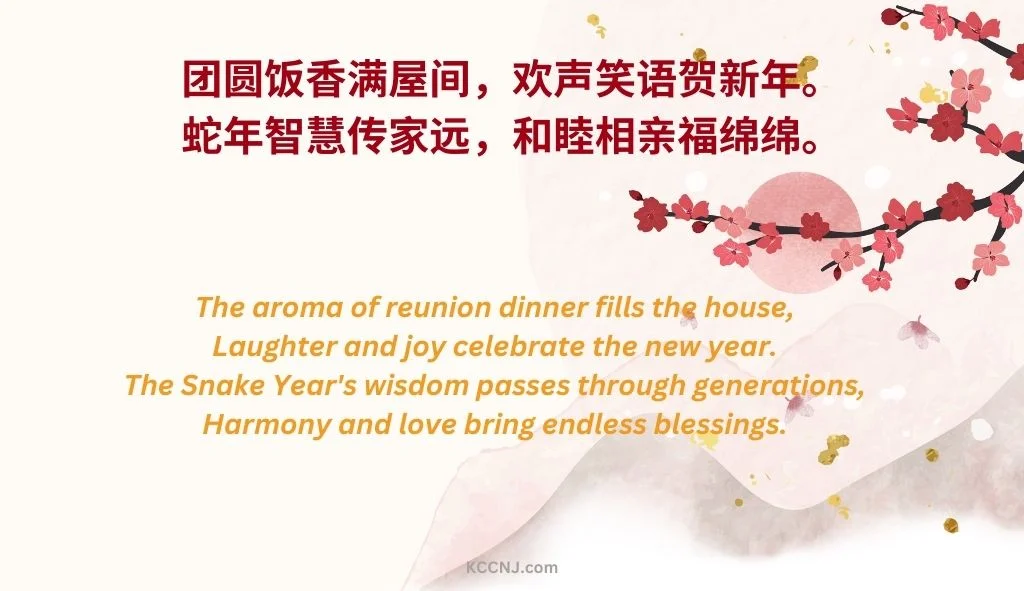
A poem celebrating the importance of family during Chinese New Year:
团圆饭香满屋间,欢声笑语贺新年。
蛇年智慧传家远,和睦相亲福绵绵。
Tuán yuán fàn xiāng mǎn wū jiān, huān shēng xiào yǔ hè xīn nián.
Shé nián zhì huì chuán jiā yuǎn, hé mù xiāng qīn fú mián mián.
In English:
The aroma of reunion dinner fills the house,
Laughter and joy celebrate the new year.
The Snake Year’s wisdom passes through generations,
Harmony and love bring endless blessings.
This poem highlights the traditional family reunion dinner and the passing of wisdom through generations, which are important aspects of Chinese New Year celebrations.
6. “Wishes for the New Year”
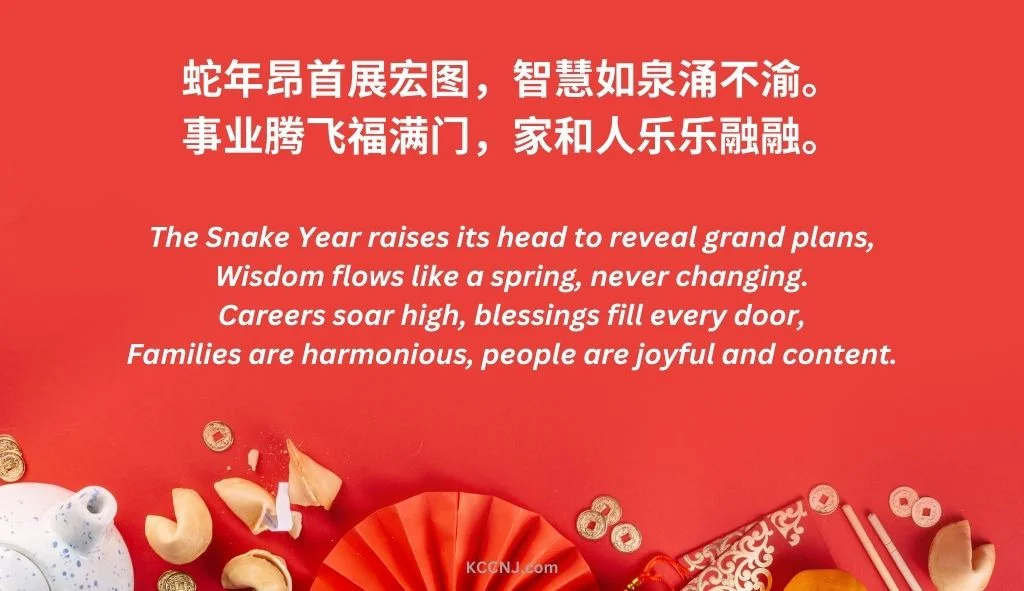
A poem expressing hopes and wishes for the coming year:
蛇年昂首展宏图,智慧如泉涌不渝。
事业腾飞福满门,家和人乐乐融融。
Shé nián áng shǒu zhǎn hóng tú, zhì huì rú quán yǒng bù yú.
Shì yè téng fēi fú mǎn mén, jiā hé rén lè lè róng róng.
In English:
The Snake Year raises its head to reveal grand plans,
Wisdom flows like a spring, never changing.
Careers soar high, blessings fill every door,
Families are harmonious, people are joyful and content.
This poem expresses common wishes for success in career, family happiness, and personal growth in the new year.
7. “Spring Festival Celebration”
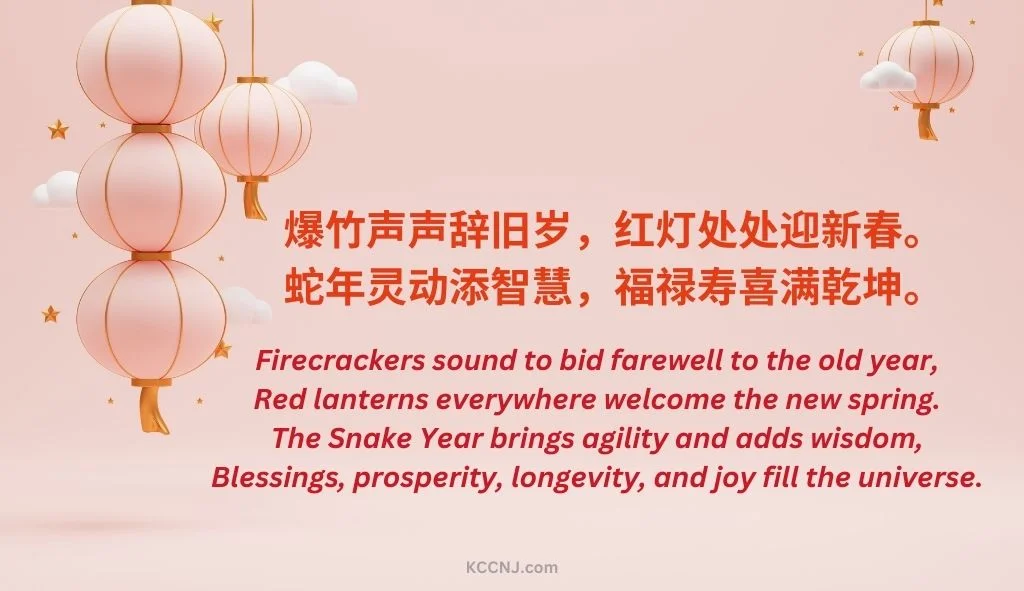
A lively poem capturing the festive atmosphere of Chinese New Year:
爆竹声声辞旧岁,红灯处处迎新春。
蛇年灵动添智慧,福禄寿喜满乾坤。
Bào zhú shēng shēng cí jiù suì, hóng dēng chù chù yíng xīn chūn.
Shé nián líng dòng tiān zhì huì, fú lù shòu xǐ mǎn qián kūn.
In English:
Firecrackers sound to bid farewell to the old year,
Red lanterns everywhere welcome the new spring.
The Snake Year brings agility and adds wisdom,
Blessings, prosperity, longevity, and joy fill the universe.
This poem describes traditional New Year customs and expresses wishes for a year filled with positive qualities associated with the snake zodiac sign.
8. “Harmony with Nature”
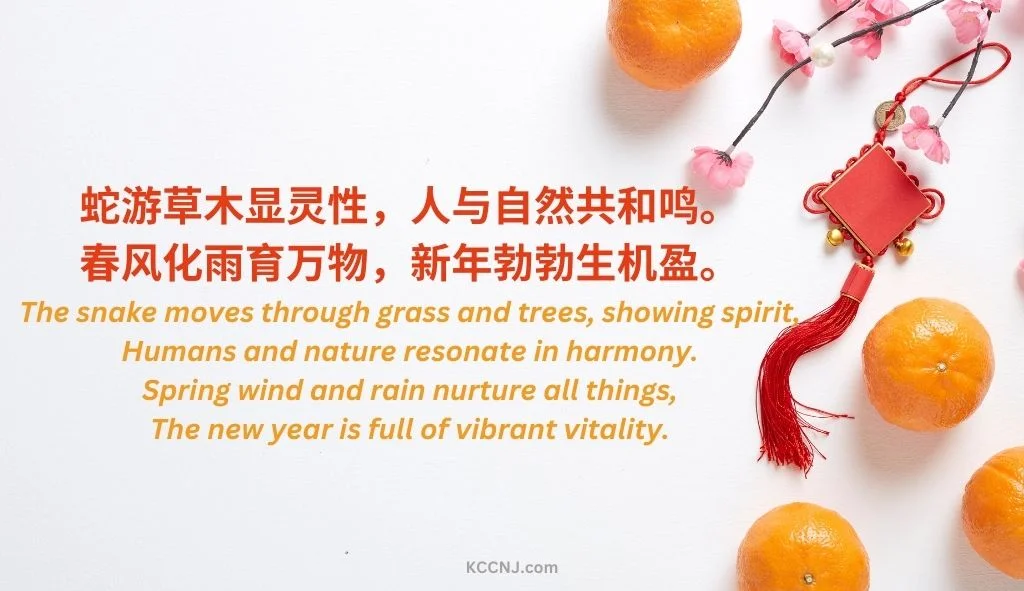
A poem emphasizing the connection between humans and nature in the new year:
蛇游草木显灵性,人与自然共和鸣。
春风化雨育万物,新年勃勃生机盈。
Shé yóu cǎo mù xiǎn líng xìng, rén yǔ zì rán gòng hé míng.
Chūn fēng huà yǔ yù wàn wù, xīn nián bó bó shēng jī yíng.
In English:
The snake moves through grass and trees, showing spirit,
Humans and nature resonate in harmony.
Spring wind and rain nurture all things,
The new year is full of vibrant vitality.
This poem reflects on the relationship between humans and nature, emphasizing harmony and growth as key themes for the new year.
9. “Looking Forward”
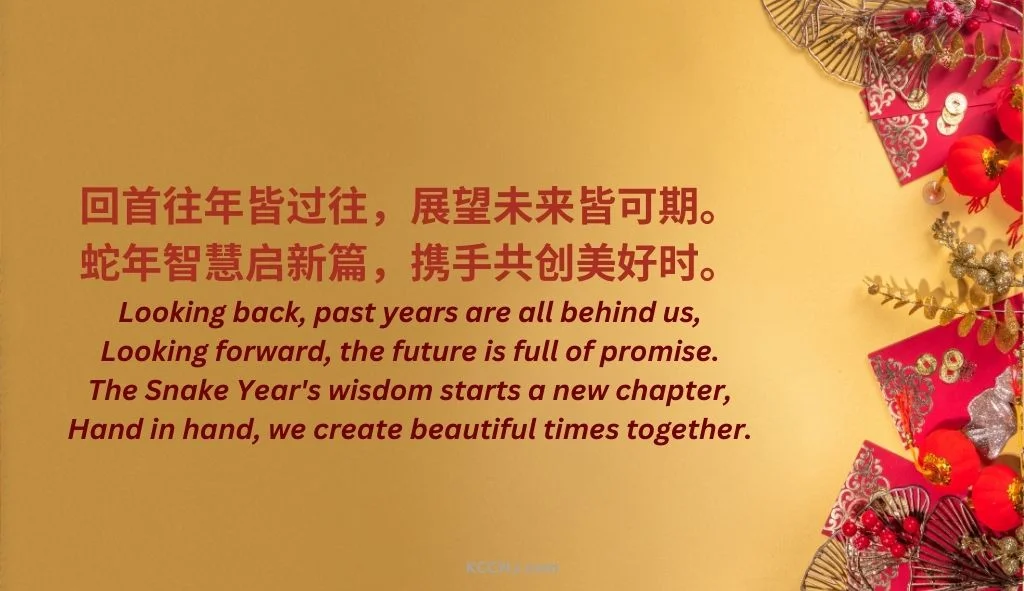
A poem that encourages optimism and forward-thinking for the new year:
回首往年皆过往,展望未来皆可期。
蛇年智慧启新篇,携手共创美好时。
Huí shǒu wǎng nián jiē guò wǎng, zhǎn wàng wèi lái jiē kě qī.
Shé nián zhì huì qǐ xīn piān, xié shǒu gòng chuàng měi hǎo shí.
In English:
Looking back, past years are all behind us,
Looking forward, the future is full of promise.
The Snake Year’s wisdom starts a new chapter,
Hand in hand, we create beautiful times together.
This poem encourages people to look forward to the future with hope and optimism, emphasizing collective effort in creating a better year ahead.
10. Wisdom’s Path
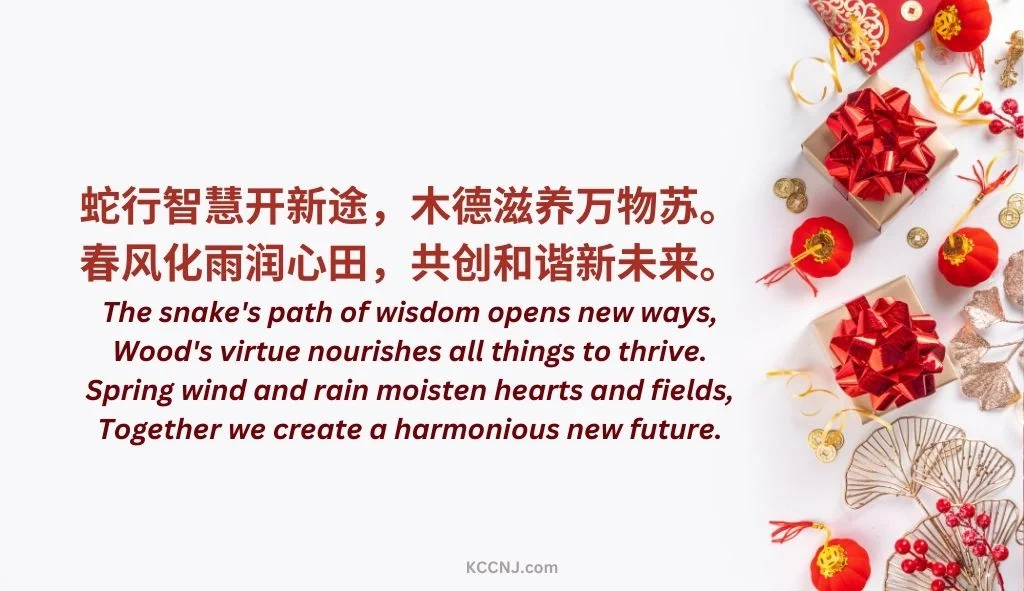
蛇行智慧开新途,木德滋养万物苏。
春风化雨润心田,共创和谐新未来。
Shé xíng zhì huì kāi xīn tú, mù dé zī yǎng wàn wù sū.
Chūn fēng huà yǔ rùn xīn tián, gòng chuàng hé xié xīn wèi lái.
In English:
The snake’s path of wisdom opens new ways,
Wood’s virtue nourishes all things to thrive.
Spring wind and rain moisten hearts and fields,
Together we create a harmonious new future.
This poem incorporates elements of the Wood Snake year, emphasizing wisdom, growth, and harmony. It reflects the hope for a prosperous and peaceful new year while maintaining the traditional structure and themes of Chinese New Year poetry.
The Art of Writing Chinese New Year Poems
Writing Chinese New Year poems is a cherished tradition that combines linguistic skill with cultural knowledge. Here are some tips for creating your own Chinese New Year poems:
Understanding the Structure
Most Chinese New Year poems follow a specific structure:
- Couplets: Two lines that complement each other
- Parallel construction: Similar grammatical structure in both lines
- Equal length: Both lines typically have the same number of characters
Choosing Auspicious Themes
Common themes in Chinese New Year poetry include:
- Renewal and new beginnings
- Prosperity and success
- Family harmony
- Good health and longevity
- Nature and seasonal changes
Incorporating Zodiac Elements
For 2025, the Year of the Snake, consider including snake-related imagery or characteristics such as:
- Wisdom and intelligence
- Flexibility and adaptability
- Mystery and charm
- Renewal (shedding skin)
Using Wordplay and Symbolism
Chinese poetry often employs clever wordplay and symbolism. This can include:
- Homophones: Words that sound similar but have different meanings
- Visual puns: Characters that look similar or share components
- Cultural symbols: Objects or concepts with traditional significance
The Role of Poetry in Modern Chinese New Year Celebrations
While traditional poetry remains an important part of Chinese New Year, its role in modern celebrations has evolved.
Digital Sharing of Poems
Many people now share New Year poems through social media and messaging apps. This has led to the creation of digital couplets and animated poems that can be easily shared with friends and family.
Fusion of Traditional and Modern Elements
Contemporary Chinese New Year poems often blend traditional themes with modern concerns, reflecting current social issues or popular culture references while maintaining the classic poetic structure.
Educational Value
Schools and cultural organizations often organize poetry writing contests or workshops around Chinese New Year, helping to preserve this cultural tradition and encourage creativity among younger generations.
- Starbucks Chinese New Year Collection
- Chinese New Year Traditional Clothes
- Chinese Snacks for Good Fortune


